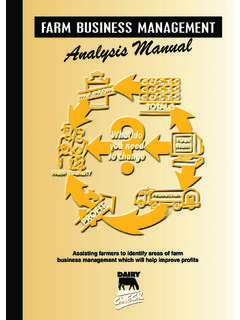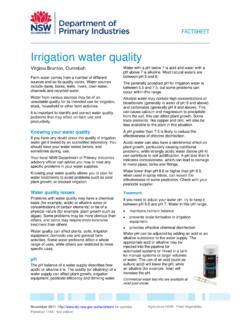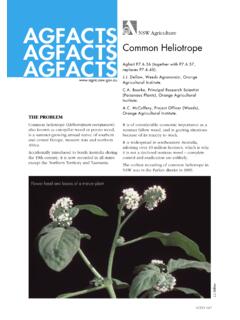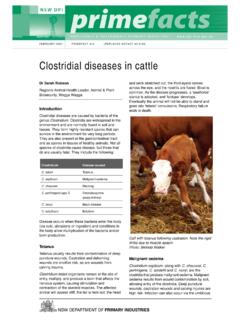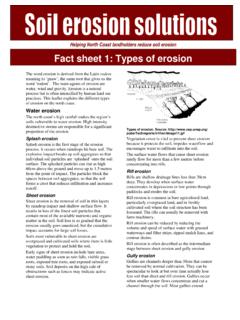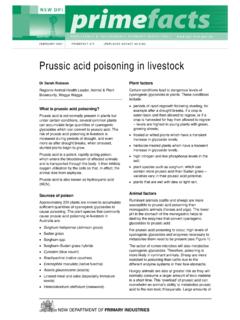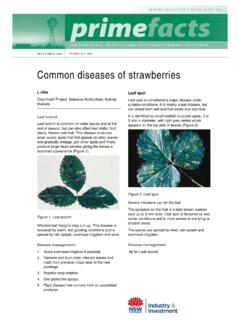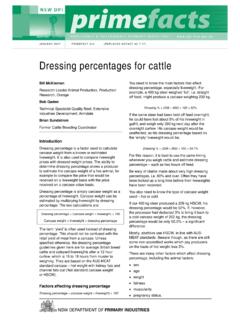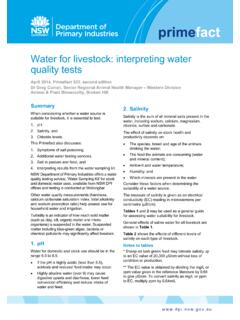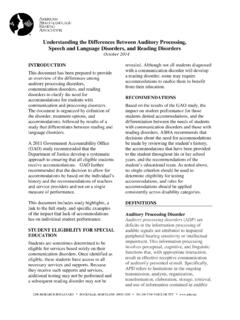Transcription of Understanding soil pH - Department of Primary Industries
1 Understanding LEAFLET Soil pH. The pH of a soil will change over time influenced by factors including parent material, weathering and current agricultural practices. It will also fluctuate through the year. Soil pH will affect how plants grow. MEASURING SOIL pH. Soil pH can be measured in the field using a test kit or by sending a sample to a laboratory for more accurate results. The standard depth of sampling is 10 cm. Acid sensitive barley Soil pH in the field can be measured using a struggling in acid soil next to simple test kit based on a colour-card method T. o understand soil acidity you need to available from agricultural supply stores called a healthy tolerant lupin crop. appreciate that soil is made up of various the Raupach soil pH kit. The kit gives the soil components which determine its properties.
2 PH on the water scale (see later) and should be These include mineral particles (sand, silt and clay, used only as a guide to soil pH. which give soil its texture), organic matter (living Analysis in a laboratory provides the most and dead), air and water. accurate measurement of soil pH. It is the best The water component is where pH is measured, basis we can have when deciding whether or not where dissolved chemicals cause the soil to be to start an acid soil management strategy such as acidic or alkaline. liming. Soil acidity and alkalinity are measured in units For further details on collecting a sample and of pH. The pH scale is from 0 (most acid) to 14 where to have it analysed see Acid Soil Action (most alkaline) and a pH of 7 is neutral. Leaflet No. 3. FIGURE 1. Plant growth and pH (CaCl2) scale.
3 Increasingly too acid Increasing alkalinity for sensitive plants leads to some plant nutrients becoming unavailable FIGURE 2. Optimum pH (CaCl2) range up to pH for a number of crops and pastures. Above pH the acidity/alkalinity is no longer the principal factor that controls growth. Other factors such as phosphorus, zinc, cobalt or boron deficiency or the sodicity of soil are most likely to affect production. CROPS pH (CaCl2) PASTURE. 3 4 5 6 7 8 9. Barley: Schooner & Yerong O'Conner & Skiff Brindabella Clover: Balansa, Berseen & Persians Red, Caucasian & Kenya Haifa white & Subterranean Canola Cereal Rye Chickpeas Faba Bean Linseed Grasses: Cocksfoot Couch Buffel Kikuyu Tall wheatgrass red grass (Wagga). wallaby grass (D. Linkii). consul love grass perennial ryegrass Lupins: Narrow leaf Broad leaf (Albus).
4 Lucerne Maize Phalaris Millet Serradella (Yellow & Slender). Trticale Oats Sorghum Soybeans Wheat: Durum Rosella & Janz Diamondbird The two main laboratory methods used in Australia use calcium chloride or water. FIGURE 3. Soil pH in calcium chloride Effect of pH (CaCl2) on the availability of soil nutrients This is the standard method of measuring soil pH. in all states other than Queensland. An air-dry soil ALKALINE. ALKALINE. ALKALINE. SLIGHTLY. SLIGHTLY. SLIGHTLY. SLIGHTLY. MEDIUM. MEDIUM. sample is mixed with five times its weight of a STRONGLY STRONGLY. VERY. VERY. ACID ALKALINE. ACID. ACID. ACID. dilute concentration ( ) of calcium chloride (CaCl2), shaken for 1 hour and the pH is measured using an electrode. The results are usually NITROGEN. expressed as pH(CaCl2). PHOSPHORUS.
5 Soil pH in water P O TA S S I U M. Distilled water is used in place of calcium chloride, and results are expressed as pH(w). SULFUR. The pH(CaCl2) test is the more accurate of the CALCIUM. two pH tests, as it reflects what the plant MAGNESIUM. experiences in the soil. The values of pH(CaCl2). are normally lower than pH(w) by to A IRON. useful, but not consistently accurate, conversion is MANGANESE. to subtract from the pH(w) to obtain a BORON. pH(CaCl2) value. The difference between the methods can be significant when interpreting COPPER & ZINC. results and it is important to know which method M O LY B D E N U M. has been used, especially if pH figures derived some years apart are being compared to assess any ALUMINIUM. pH fluctuations. pH (CaC12). Understanding . SOIL pH RESULTS.
6 Soil pH effect on plant response A soil pH(CaCl2) of to provides optimum conditions for most agricultural plants (Figure 1). All plants are affected by the extremes of pH but there is wide variation in their tolerance of acidity and alkalinity. Some plants grow well over a wide pH range, whilst others are very sensitive to small variations in acidity or alkalinity. Figure 2 provides a guide to the preferred pH(CaCl2) for some common crops and pastures. Microbial activity in the soil is also affected by soil pH with most activity occurring in soils of pH. to Where the extremities of acidity or alkalinity occur, various species of earthworms and nitrifying bacteria disappear. Legume root colonising bacteria (Rhizobia) vary in their sensitivity to soil pH and have preferred ranges in The effect of aluminium toxicity on the which they are effective.
7 In some crops and roots of Condor wheat. From left to right, pastures ( faba beans and lucerne) the Rhizobia the plants were grown in solutions specific to these plants are more sensitive than the containing 0, 10 and 20 ppm aluminium. plant itself. Soil pH effect on availability of soil nutrients Soil pH affects the availability of nutrients and how the nutrients react with each other (Figure 3). At a low pH, beneficial elements such as molybdenum (Mo), phosphorus (P), magnesium (Mg) and calcium (Ca) become less available to plants. Other elements such as aluminium (Al), FURTHER INFORMATION. iron (Fe) and manganese (Mn) may become more For further information on Understanding soil available and Al and Mn may reach levels that are pH, see the NSW Agriculture publication Agfact toxic to plants.
8 The changes in the availability of Soil acidity and liming, and Acid Soil Action nutrients cause the majority of effects on plant Leaflets 3 to 6, and the chapter on soil chemistry in growth attributed to acid soils. Sensitive crops such Soils: Their Properties and Management, as barley and lucerne can be affected by small Charman and Murphy (eds), second edition, amounts of exchangeable aluminium. (Oxford University Press, Melbourne). Consequently, knowledge of the soil pH and associated aluminium toxicity is vital before Belinda Lake planning to sow crops or pastures. Yanco Agricultural Institute Phone (02) 6951 2629. In contrast, when the pH(CaCl2) is greater than June 2000. , calcium can tie up phosphorus, making it less available to plants. Additionally, alkaline soils cause zinc and cobalt deficiencies that lead to stunted plants, poor growth and reduced yields in some crops and pastures.
9 Soil pH trends over time Monitoring pH changes over time is an important management tool. By comparing past and present soil tests, it is possible to see if the soil acidity is increasing over time and, if it is, to alter management methods to prevent this trend from continuing. DISCLAIMER: The information contained in this publication is based on knowledge and Understanding at the time of writing (June 2000). However, because of advances in knowledge, users are reminded of the need to ensure that information upon which they rely is up to date and to check currency of the information with the appropriate officer of New South Wales Department of Agriculture or the user's independent adviser. This leaflet is one of a series on Acid Soil Management, prepared for the New South Wales Acid Soil Action Program by Belinda Lake, Acid Soils Project Officer, Yanco, June 2000.
10 2090. 2090.
